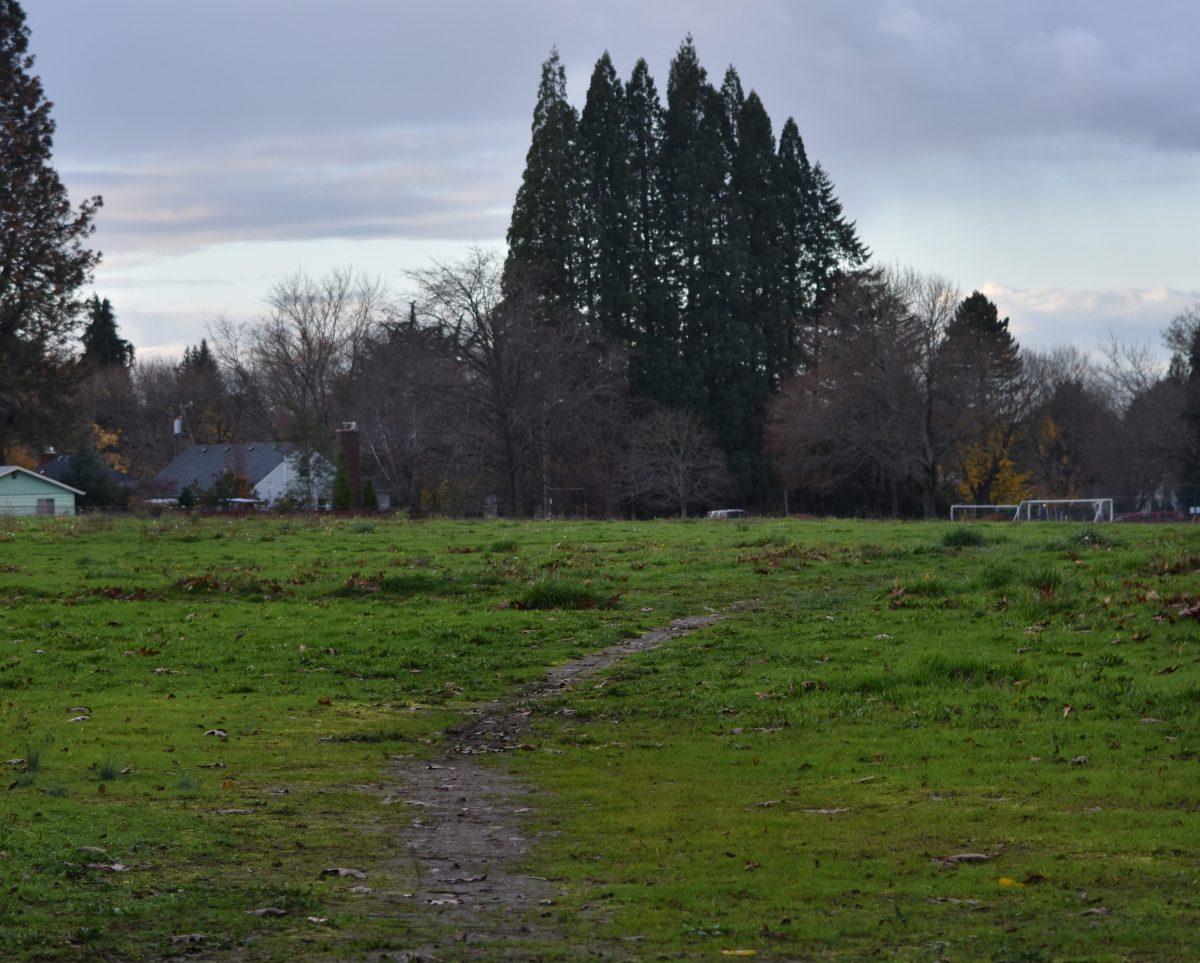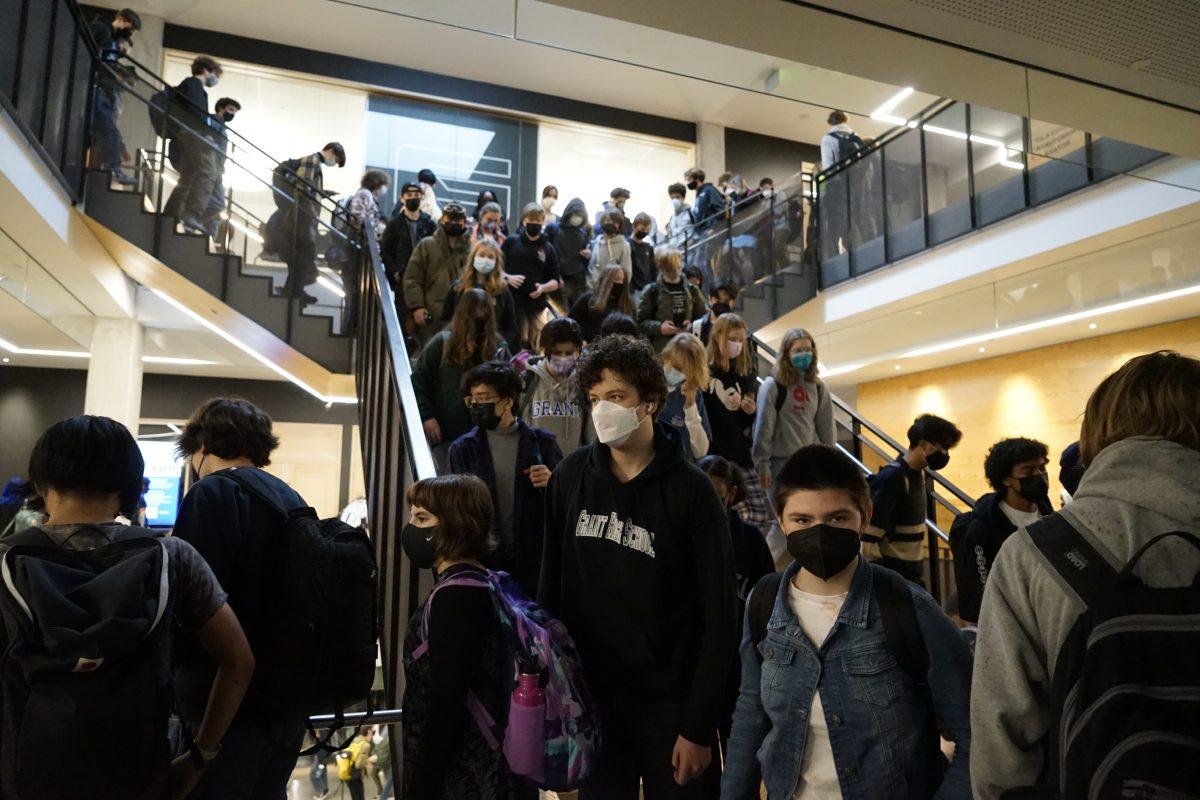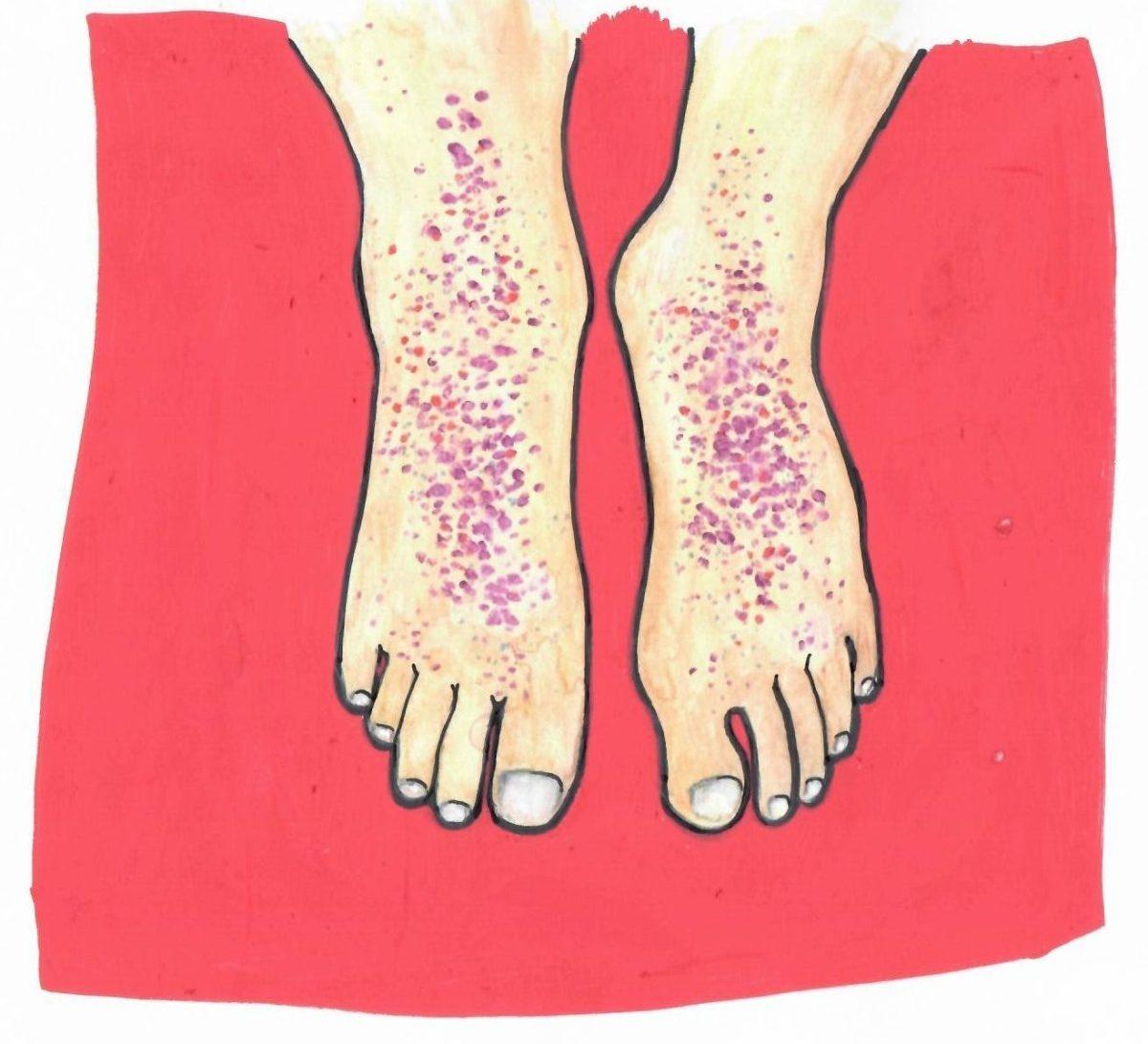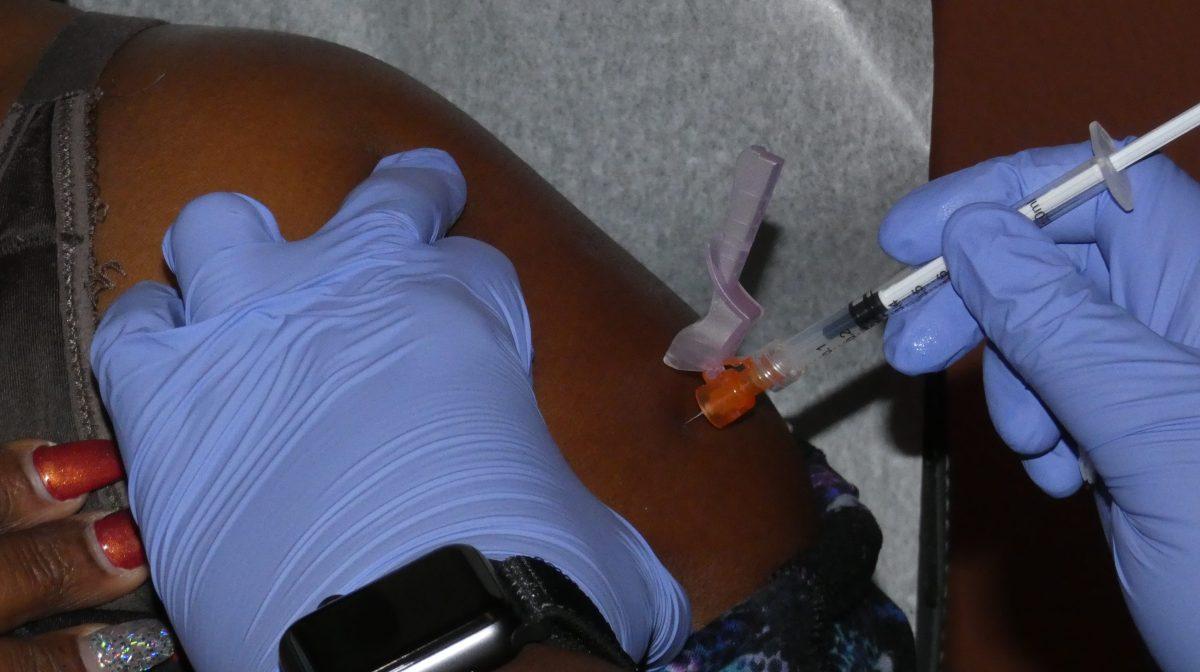On the south end of Fernhill Park in Northeast Portland, a barren field marks the grave of Whitaker Middle School. The dead grass of the former school site is a stark contrast to the rest of the lush, well-maintained park. It’s hard to believe this unoccupied area once served as the home for over 900 students. Prior to its demolition in 2007, distinctive brutalist architecture characterized the gargantuan building that resembled a warehouse just as much as a school. The massive concrete structure was built on a radon-rich soil, which would lead to its eventual demise.
Outdated architecture and poor ventilation combined with its unfortunate location created a multitude of building safety issues that silently tore Whitaker apart over ten years. Lack of action by Portland Public Schools (PPS) to fix these problems led to the school’s closure in 2001 and its eventual demolition six years later.
In the years following the closure of Whitaker, further evidence of building mismanagement in PPS was unveiled, revealing communication and management issues within the district.
Building safety procedures within PPS continue to be in question as the long-term health effects caused by Whitaker begin to reveal themselves 20 years after the school’s closure.
The building that came to be Whitaker Middle School was first constructed in 1969 as Adams High School. Adams closed in 1981, and Whitaker Middle School, then located in an overcrowded building nearby, moved in.
“The school was beautiful,” says former teacher Grace McKenzie.
Its large size allowed for a variety of facilities, including a photography lab, a metal and wood shop, a large gym and a glass atrium.
This may have seemed like a good deal for Whitaker students at the time, but the building was riddled with structural problems.
Not a single window in the school opened, leading to poor ventilation within. “It was one of those schools where everything always just seemed really dark and damp. A lot of us would always get sick,” says Karen Teeter, class of 1993.
In a 1999 report on the school issued by PPS, Whitaker was recorded as having the lowest test scores in the state and high rates of absenteeism. “A lot of the kids couldn’t stay there for a full day. They would get sick by the end of the day,” McKenzie says, “Many kids developed sinus infections, migraines and asthma.”
Former students recall this too. “I started getting headaches and migraines when I started at Whitaker,” says Teeter. “I would get a lot of coughs and colds as well.”
This widespread sickness among students correlated with the symptoms of toxic mold exposure, and rumors that there was a mold infestation in the school began to spread.
According to the CDC, “Mold can cause a stuffy nose, sore throat, coughing or wheezing, burning eyes, or skin rash.”
Dishaun Berry and Vanessa Simpson, both class of 1993, remember developing asthma soon after leaving Whitaker. “The research is clear that mold and damp building exposure is a major factor in the asthma epidemic,” says the National Library of Medicine.
During her first year at Whitaker, Audrey Zimmerman, class of 2000, developed migraines and asthma. Her symptoms continued into her second and third year at the school, and she consistently missed class due to sickness.
“My mom was missing time (at work) because I was home sick. I was vomiting, and I had extreme migraines to the point where I couldn’t get out of bed,” says Zimmerman.
Teachers were not immune to these health problems, as many reported symptoms of their own during their time at the school. “I just remember some days being in a daze … my system would start to shut down, and I had to get out of there,” says former teacher Janice Ingersoll. “How can you learn if you can’t breathe?”
McKenzie remembers receiving a shocking check-up from her doctor during her time at Whitaker. “The doctor said that my heart and lungs look healthy for a smoker. I don’t smoke. And I said, ‘I don’t smoke’. He said, ‘you sure?’”
Employees who tried to question the safety of the building were quickly met with disapproval and ignorance from the administration. Ingersoll recounts being told by a district-sponsored psychiatrist that she was “suffering from depression, anxiety” and might be having a “midlife crisis”. The claims were not substantiated by her personal doctor.
“We called (PPS) all the time to let them know what was going on,” says McKenzie, “And they would come back with, ‘Oh, everything’s fine. You guys just don’t know what you’re talking about.’”
More than a few teachers submitted workers compensation claims, and the majority were denied. PPS’s denial continued even after the story went public in May of 2001, when Willamette Week published an article on Whitaker, revealing what many had long suspected about the building conditions.
As far back as 1991, ten years prior, PPS was aware of the high concentration of radon in the building. In 1998, the district conducted what was likely a flawed inspection, which found no evidence of mold or other building issues.
“Whenever there was going to be a large check of radon, the doors would be kept open. And there were gigantic fans placed on that lower level before the test was going to be done,” says Lynette Wortham, a former teacher.
According to Jeffrey Rook, the head of Environmental Health and Safety at PSU, “In order to get a high reading of radon, you need to have the room buttoned up and closed.”
In June 2001, a committee of parents and teachers decided to take matters into their own hands, issuing a private inspection by a third-party company.
The results were devastating. Radon was found at levels up 21 picocuries per liter, with a building average of 9.4. To compare, the maximum “acceptable” level of radon is 4 pCi/L according to the Environmental Protection Agency.
“Overconsumption of radon can lead to lung cancer,” says Rook. “Radon will naturally dissipate if you have airflow. But if you don’t have airflow through a space, it lingers and collects in higher quantities.”
Additionally, an immense mold infestation was found that had likely been in the building for years.
The inspector recommended the school remain closed until money was available for a complete repair, and with that, the building was vacated. Some teachers finally began to see a few of their compensation claims accepted, while others prepared to sue.
The building was completely shut down and condemned by the end of the school year. The closing took with it the unique community the school had, and disrupted the vulnerable demographic it served.
“It was always nice to be around and see more of me (Black people) than anybody else, that’s for sure. It was a great experience. I loved Whitaker. But the district had another plan for Whitaker,” says former PE teacher John Mays.
20 years later, the teachers and students of Whitaker are seeing how they’ve been affected long-term. “It’s definitely something that should be brought to awareness. That way it doesn’t happen somewhere else and there’s not another community, and another school and another generation after generation that’s affected by something like this,” says Teeter.
Both students and teachers feel their health has been compromised by their time at Whitaker, and they’ve never seen proper reconciliation.
“Most recently, some students contacted me,” says Ingersoll, “They had been diagnosed with something they’re attributing to Whitaker.”
That something is sarcoidosis, a painful lung condition. According to the Stanford Sarcoidosis Program, mold is “among the many risk factors for the development of sarcoidosis.”
“I know a disproportionate number of people who work there who seem to have respiratory issues now,” says Wortham, who herself deals with asthma and congestion.
Zimmerman endured symptoms long after leaving Whitaker, continuing to experience sickness through the duration of her high school years. The extreme nature of her illness had caught PPS’s attention while she was in high school.
“The school had all these doctors at OHSU that had put me in glass tubes, all sorts of things. It was the worst experience ever … I had to go back and get all these tests done because I was still sick. The doctors said at that point in time, yes I was sick, but I won’t see the effects of the black mold and radon until I hit my 30s,” she says.
They were right. When Zimmerman turned 30, she had her first brain aneurysm. ̈I’ve almost died on multiple occasions, all stemming from black mold,” she says.
Doctors Zimmerman has seen over the years agree. “We made the connection between my health issues and Whitaker a long time ago,” she says, “It’s destroyed my life … I wish I never went to Whitaker. ̈
Other students have experienced effects over time as well. Teeter continues to experience chronic migraines, as well as unexplained gastrointestinal problems.
JD Spradley, class of 1999, and Simpson have endured stomach issues into their adult lives as well. “It’s been downhill since Whitaker,” Spradley says, “I’ve had these issues for most of my life … It’s been exasperated, just gotten worse.”
Simpson says, “From the time I was 13-years-old until now, I have a lot of memories of having stomach issues. ̈

Students and staff were left with a tenuous close to Whitaker, with the district promising to change their practices. “Now, we’re proactively inspecting school buildings,” said then soon-to-be interim superintendent Jim Scherzinger in an interview with Education Weekly in 2001.
Scherzinger added, “This will help ensure a situation such as the one at Whitaker will not happen again.”
But it did.
15 years later, in May of 2016, PPS revealed to the public that there were high levels of lead in the water in schools. The district claimed to have come across this knowledge two months prior after high lead levels were found in the water of Creston School and Rose City Park School.
Not only was this information withheld for two months before being released to the public, old PPS testing records were uncovered to show that high levels of lead were also found in 47 buildings from 2010 to 2012. No district employees admitted any knowledge of the records.
In a report written by Stoll Berne Law Firm
investigating the lead problem, it says, “The EPA recommends best practices including telling students, parents, staff and the larger community about monitoring programs, potential risks, the results of testing and remediation actions.”
This was not practiced at all in 2001 and between 2010-2012.
Additionally, after the disaster at Whitaker, it was promised that building inspections would become routine, and no longer complaint based. This change did not happen.
In the Stoll Berne report, it concluded, “PPS’s activities between 2002 and 2016 relating to testing drinking water for lead were primarily reactive and performed in response to inquiries from parents or staff.”
PPS’s trend of mismanagement has impacted students across the district, yet the Whitaker community is left wondering if the school’s demographics heightened the neglect they experienced. Of those enrolled, 77% were students of color, compared to the PPS average of 38% at the time. “I did feel that the school, because of its racial makeup, did not get the attention it needed to,” says former principal Cynthia McLeod. “They (PPS) didn’t want Whitaker to succeed, no. They had a plan and they implemented that well,” says Mays.
When asked if she thinks PPS still struggles with issues of equity today, McLeod, who was also the assistant director of equity at PPS, says, “I do. I definitely think that’s still true. If you have a middle school which has a high population of kids living in poverty, there are services that are needed to mitigate the impact of that poverty.”
Services that Whitaker students never received. These issues were left unresolved, leaving Whitaker’s former building vacant for years before being demolished in 2007. Only a desolate field remains.
Since then, ideas for the site have been proposed: a state-of-the art community sports facility serving the local population, and a safe rest village that will provide temporary homes for homeless people. However, the land is still owned by PPS, and no formal plans have come forward to do anything with the site.
Until any headway is made, the former site of Whitaker Middle School will remain an empty field of dead grass. Although the school has been destroyed, the memory of the school’s mistreatment and its resulting health effects still impact the Whitaker community to this day.♦
































